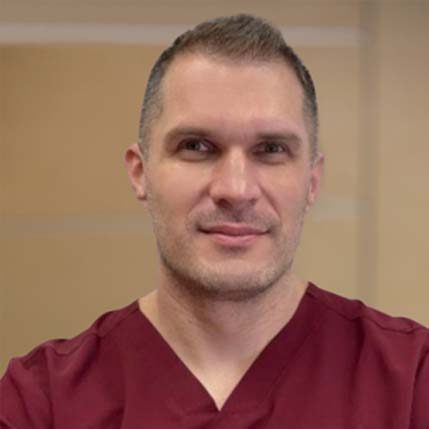Myomectomy Specialists at CIGC
Our board-certified, fellowship-trained specialists at CIGC have performed more than 25,000 advanced GYN procedures, including myomectomies to treat uterine fibroids and preserve fertility. CIGC’s specialists offer unsurpassed myomectomy care with your fast recovery in mind while paying careful attention to your physical and emotional well-being throughout your treatment. Caring for our patients with dignity and respect is part of our mission and our commitment to you.
We developed a state-of-the-art, minimally invasive procedure to remove fibroids of all sizes and provide relief from symptoms such as pelvic pain, abnormal bleeding and infertility. Our goal with myomectomy treatment is to provide you with relief that will improve your quality of life, preserve your uterus for pregnancy and give you an alternative to hysterectomy.
CIGC specialists focus 100% on innovative, minimally invasive GYN surgery for complex conditions like endometriosis, fibroids, uterine prolapse and adenomyosis. Unlike a standard OBGYN, CIGC surgeons perform thousands of advanced GYN surgeries per year, perfecting techniques and reducing complication rates.
CIGC’s advanced surgical techniques go far beyond traditional treatment methods to ensure patients have next-to-no scarring and quick recoveries. We provide every patient with a personalized treatment plan and the compassionate care they deserve.
CIGC’s Advanced Myomectomy
The physicians at The Center for Innovative GYN Care® (CIGC®) provide women with the best myomectomy experience possible by performing surgery with the groundbreaking LAAM® technique. LAAM results in the fastest recovery with minimal pain and barely noticeable scars.
The LAAM procedure is not performed by a robot, but with a surgeon’s hands. The manual component allows the surgeon to find and dislodge growths too small to be detected during other kinds of laparoscopic surgery.
The Alternative to Hysterectomy
Women whose fibroids are interfering with their quality of life can find permanent relief with a minimally invasive hysterectomy. Removing the uterus leaves no place for fibroids to grow back.
For women who wish to preserve their fertility or do not wish to have a hysterectomy, CIGC’s myomectomy can offer a reprieve from the distressing symptoms of fibroids by individually removing each growth — both large and small, regardless of where in the uterus they are located. The uterus remains intact, strengthened by hand suturing at each removal site.
CIGC’s laparoscopic specialists are experts in myomectomy and hysterectomy procedures and can help you determine the best fibroid treatment for your individual concerns.
Patient Success Story
“In 2008, my fibroids were the size of a golf ball. By 2015, they had turned into grapefruit size. Several people kept telling me about CIGC, and I went for a consultation. I had [a myomectomy] and went back to work a week later. A year after the surgery, I was pregnant — and now have a beautiful baby girl!”
Unparalleled Results with LAAM Myomectomy
Women experience superior outcomes when their myomectomy is performed by CIGC specialists using the innovative LAAM surgical technique.
| LAAM Procedure | Standard Laparoscopic | Robotic | Open | |
|---|---|---|---|---|
| Length of Procedure | 74-90min1 | 107-124min1 | 159-252min1 | 229-275min1 |
| Number of Incisions | 21 | 3–45,6 | 4–58,10 | 1 x 10–15 cm13,14 |
| Max Number of Fibroids Removed | 1031 | 181 | 131 | 651 |
| Hospital Stay | 0 Days1 | 1 Day14 | 1 Day4,11 | 2–3 Days4,11 |
| Recovery Time | 10–14 Days1 | Up to 3 Weeks7,17 | Up to 3 Weeks12 | Up to 8 Weeks10,15,16 |
| Conversion to Open Surgery | 0.7%1 | 22.9%1 | 8.2%1 | N/A |
Why CIGC?
A Gynecological Surgery Center of Distinction
CIGC is recognized as a Center of Excellence in Minimally Invasive Surgery by the American Association of Gynecologic Laparoscopists (AAGL).
Advanced Techniques
Unlike the standard GYN surgical techniques, our DualPortGYN and LAAM® procedures allow patients to return home the same day. These advanced techniques also provide shorter recovery times and better outcomes. We care for each patient as a true individual through a detailed and personalized approach that puts your needs as a patient first.
Compared to open, robotic-assisted and standard laparoscopic techniques, CIGC surgical specialists use fewer and smaller incisions to minimize scarring and speed up recovery, resulting in lower complication rates. We get our patients back to their daily lives in one to two weeks on average — free from their GYN symptoms and worries.
Patient Success Stories
“When the situation seems complicated to another doctor, the first thing they want to say is, ‘Oh, you need a hysterectomy.’ I did my own research and got in touch with CIGC. Don’t get that hysterectomy. Don’t give up.” — Ashley, who sought out LAAM to preserve her fertility
“I had the LAAM procedure. I am seven days post-surgery, and I can honestly say I am stunned at how good I feel today! I could have gone back to work three days ago if it wasn’t for the nature of my work. I feel excellent!! Please, if you are on the fence about this procedure, just do it! You will not have any regrets!” — Dalley
Our Doctors
Our minimally invasive GYN specialists are fellowship-trained and renowned for their leadership and expertise in the diagnosis and management of complex GYN conditions. They have innovated advanced minimally invasive gynecological surgery techniques, such as DualPortGYN® and LAAM®, for women of all ages.
Our Centers
CIGC surgeries are performed at ambulatory surgery centers that are not attached to a hospital, meaning procedures are done on an outpatient basis and patients can go home the same day. With convenient locations near major cities like Washington, D.C., and New York City, each center is fully designed with state-of-the-art equipment and staffed with friendly, compassionate professionals. We follow CDC guidelines to ensure the enhanced cleanliness and safety of each center. During the ongoing COVID-19 pandemic, we are offering telemedicine consultations in addition to in-person appointments to discuss treatment options.
References:
2 Bedient CE, Magrina JF, Noble BN, et al. Comparison of robotic and laparoscopic myomectomy. AJOG, 2009;201:566.e1-5.
3 Sangha R, Eisenstein D, George A, Munkarah A, Wegienka G. Comparison of surgical outcomes for robotic assisted laparoscopic myomectomy compared to abdominal myomectomy. JMIG, 2010; 17(Suppl):S108.
4 Barakat et al. Robotic-Assisted, Laparoscopic, and Abdominal Myomectomy: A Comparison of Surgical Outcomes. 2011; 117(2): 256-266.
5 Rossetti, A., Sizzi, O., Chiarotti, F., & Florio, G. (2007). Developments in techniques for laparoscopic myomectomy. JSLS. 11(1), 34-40.
6 Seinera et al. Laparoscopic myomectomy: indications, surgical technique and complications. Human Reproduction vol.12 no.9 pp.1927–1930, 1997.
7 Alessandri, Franco et al. Randomized study of laparoscopic versus minilaparotomic myomectomy for uterine myomas. JMIG. 2006; 13(2):92-97.
8 Advincula AP, Xu X, Goudeau S, Ransom SB. Robot-assisted laparoscopic myomectomy versus abdominal myomectomy: a comparison of short-term surgical outcomes and immediate costs. JMIG. 2007;14:698–705.
9 Sangha R, Eisenstein D, George A, Munkarah A,Wegienka G. Comparison of surgical outcomes for robotic assisted laparoscopic myomectomy compared to abdominal myomectomy. JMIG. 2010;17(Suppl):S108.
10 Asmar J, Even M, Carbonnel M, Goetgheluck J, Revaux A and Ayoubi JM (2015) Myomectomy by robotically assisted laparoscopic surgery: results at Foch Hospital, Paris. Front. Surg. 2:40,
11 Gobern JM, Rosemeyer CJ, Barter JF, Steren AJ. Comparison of robotic, laparoscopic, and abdominal myomectomy in a community hospital. JSLS. 2013;17(1):116-20.
12 Mayo Clinic
13 Yeung P, Bolden C et al. Patient Preferences of Cosmesis for Abdominal Incisions in Gynecologic Surgery. JMIG. 2013; 20(1): 79-84,
14 Jones, H. W., III, & Rock, J. A. (2015). Te Linde’s operative gynecology (Eleventh edition). Philadelphia: Wolters Kluwer.











